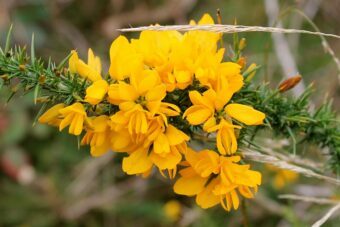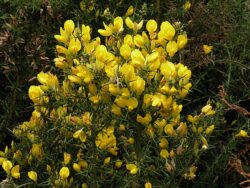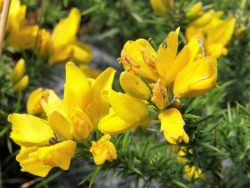In this article, we will discuss how to grow the pretty shrub of Ulex in containers. Ulex is a genus of flowering shrub that belongs to the Fabaceae (the Pea) family, where 20 species are known to exist, they have the common name of Gorge, Furze or Whin, depending on what country you are from. This is one shrub that is native to the UK, but it can also be found in Western Europe and Northwest Africa. The greatest source is found in the Iberia Region.

As you can imagine by looking at them they are closely related to Genista (the Broom), as, after all, they belong to the same family of Fabaceae. It is commonly found growing in the countryside of the UK.
They have green stems, very small leaves and can grow in dry growing conditions. The plants are extremely thorny, making them useful hedging plants. The shoots of the branches are modified into thorns 1 to 4cm long, which almost replace the primary source of photosynthesis in the plant. The green, small leaves are trifoliate in shape, but as the leaves mature the leaves are reduced to scales or small spikes. In spring, it bears masses of fragrant pea-like, yellow flowers, which is the main reason why the plant is grown. Some species will flower in autumn, giving additional colour at a bleak time.
Find out how to grow Ulex (Gorse) in containers in this article.
GROWING ULEX IN CONTAINERS
First, you must realise that Ulex hates to be transplanted, so when buying choose a small container–grown specimen as possible. A root-bound pot plant will not do as well.
Choose a container that is well-balanced and with proportions to the shrub in question. Whatever you choose, make sure it has plenty of drainage holes at the bottom, as the shrub hates to be waterlogged. To this container add a 5cm layer of gravel to aid drainage even more. You will need to create a free-draining growing media by mixing 70% by volume of topsoil with 30% by volume of washed building sand, Fill the container within 5cm below the top rim with this growing media.
Dig a hole at the centre of the container slightly bigger than the root ball it came in the original, small container you bought it in. Place the plant in so that the top of the root ball is at the same level as the top surface of the compost within the container. Backfill with the growing media so that no visible vacant spaces remain, using more compost if you find it necessary. Firm the plant in and water well to allow the growing media to settle around the roots.
THE BEST GROWING CONDITIONS
You must place the shrub and container in a sunny spot to be at its best. Water well until it is well-established, which can be up to a year. After this, it can take drought pretty well but it is advised to water when 5cm below the top surface of the compost feels dry to the touch. When you water do so until it just emerges from the drainage holes.
Do not fertilize at all as with too much feed they will grow tall and lanky. They are used to growing in poor soil in their native lands. Only feed with a weak, liquid fertilizer of the plant is showing obvious signs of a nutrient deficiency (i.e. yellowing of leaves). See my article on nutrient deficiencies on how to spot and deal with them.

Pruning is necessary to keep the plant bushy and to neaten them up. It is recommended that you trim back the stems after it has finished flowering.
Propagation is either via seed sowing or by taking semi-ripe cuttings in summer and placing them in a cold frame.
To grow from seed you will need to soak them to soften the hard seed coat and to leach out any chemical inhibitors that may prevent germination. To do this, you will need to soak the seeds for one to three hours in hand hot water. Once they have started to swell, you will need to plant them in seeds compost straight away.
As they hate to be transplanted, you will need to grow them in 10cm pots full of a mix of 70% by volume seed compost and 30% silver sand. Place the seed on the surface and just cover it with a thin layer of sieved compost. Place it under heat and after 2 to 3 weeks the plant will have germinated. Remove the pots from heat and allow the young seedlings to grow on before hardening off and planting outside. You can start the seeds in spring.
PESTS AND DISEASES
It is lucky that Ulex does not suffer from pests and diseases, so is great for those who do not want a demanding shrub. The only problem is that Ulex europaeus (the Common Gorse) can be severely damaged in cold, harsh, severe winters. They may need the protection of a thick, horticultural fleece in case harsh, frosty weather is forecasted.
VARIETIES TO GROW

The usual species you will find is Ulex europaeus, which grows up to 2m high and is densely spiked. It bears masses of fragrant, yellow, pea-like flowers between March and May.
A better and more popular species and variety is ‘Plenus’ which you may find sold as ‘Flore Pleno’. It only grows up to 1.3m tall and bears an abundance of semi-double flowers in spring.
For the autumn flowering species, which are less popular and are dwarfs. These include Ulex gallii ‘Mizzen’ that grows up to 60cm high and the minute 45cm tall Ulex minor.
CONCLUSIONS
In this article, we have discovered how to grow the beautiful flowering and native shrub of Ulex in containers. They are easy to grow, easy to care for, pests and diseases free and do not even require fertilizing.
If you want a native British plant that will do well in containers then this is a shrub for you. If you have any questions or comments that you wish to make on growing Ulex in containers, please do so in the comment box below.
Happy Ulex growing.
